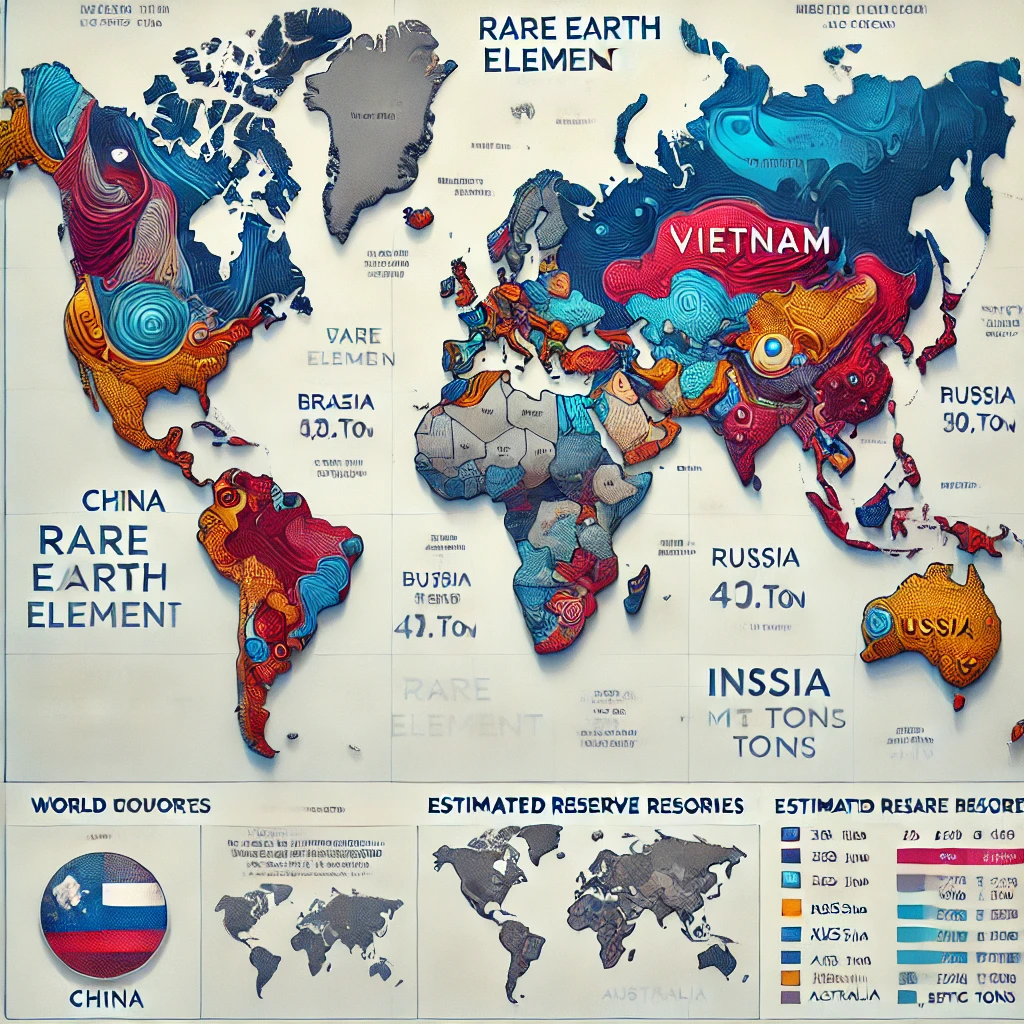Rare earth elements (REEs) are a group of 17 metals essential for various high-tech applications, including electronics, renewable energy, and defense systems. Despite their relative abundance in the Earth's crust, economically viable concentrations are rare, leading to challenges in extraction and production.
Global Reserves and Production by Continent and Country
The distribution of rare earth reserves and production varies across continents and countries. Below is an overview of the leading nations by their estimated reserves and production rates:

China leads both in reserves and production, accounting for a significant portion of the global supply. Other countries like Brazil, India, and Vietnam possess substantial reserves but have relatively low production levels, indicating potential for future development.
Ukraine's Rare Earth Potential
Ukraine's potential in rare earth elements is based on Soviet-era geological assessments, primarily from the 1960s to 1980s. Notably, the Novopoltavske deposit in the Zaporizhzhia region was identified during this period. However, these evaluations are outdated, and no significant commercial exploration has occurred in recent decades. Additionally, more than 70% of these deposits are located in regions currently not under Ukrainian control, such as the Donetsk and Luhansk areas, further complicating potential extraction efforts.
Production Rates by Type of Rare Earth Element
Rare earth elements are categorized into light rare earth elements (LREEs) and heavy rare earth elements (HREEs). The production rates of specific REEs vary by country, depending on the composition of their mineral deposits:
- China: Dominates the production of both LREEs (such as cerium, lanthanum, and neodymium) and HREEs (like dysprosium and terbium), largely due to its extensive mining and processing infrastructure.
- United States: Primarily produces LREEs, with the Mountain Pass mine focusing on elements like cerium and neodymium.
- Australia: Through companies like Lynas Rare Earths, Australia produces significant quantities of LREEs, including neodymium and praseodymium.
- India and Russia: Have the potential to produce both LREEs and HREEs but currently have limited production capacities.
Geographic and Political Challenges in Rare Earth Extraction
The extraction and supply of rare earth elements are influenced by various geographic and political factors:
- China's Dominance: China's control over rare earth processing and magnet manufacturing poses strategic vulnerabilities for other nations reliant on these materials.
- Environmental Concerns: Mining and processing rare earth elements often result in environmental degradation, including radioactive waste. Countries like Myanmar and regions within China have faced significant environmental challenges, leading to stricter regulations and, in some cases, mine closures.
- Geopolitical Tensions: The concentration of rare earth reserves in specific regions can lead to geopolitical tensions. For instance, Greenland's vast reserves have attracted interest from major powers, raising concerns about environmental impacts and sovereignty.
- Infrastructure Limitations: In regions like Greenland, harsh weather conditions, sparse infrastructure, and bureaucratic hurdles pose significant challenges to mining operations.
- Conflict Zones: In Ukraine, the majority of rare earth deposits are located in conflict-affected areas, making exploration and extraction currently unfeasible.
In summary, while rare earth elements are globally distributed, their production is concentrated in a few countries, primarily China. This concentration, coupled with environmental, geopolitical, and infrastructural challenges, underscores the need for diversified and sustainable supply chains for these critical materials.
Visualizing Rare Earth Reserves
For a comprehensive visual representation of global rare earth reserves, you can refer to the following resources:
- British Geological Survey: Offers a detailed map of global rare earth element mines, deposits, and occurrences, providing insights into both current mining operations and potential reserves.
- HiTech AlkCarb Project: Features an interactive map detailing global rare earth element mines and deposits, focusing on hard-rock sources and their geological contexts.
These resources offer valuable insights into the geographic distribution of rare earth elements, aiding in the understanding of global supply dynamics and potential areas for exploration and development.
Rare earth elements (REEs) are a group of 17 chemically similar metallic elements. They are divided into light rare earth elements (LREEs) and heavy rare earth elements (HREEs) based on their atomic numbers and properties.
Full List of Rare Earth Elements (REEs)
Light Rare Earth Elements (LREEs)
- Lanthanum (La)
- Cerium (Ce)
- Praseodymium (Pr)
- Neodymium (Nd)
- Promethium (Pm) (radioactive, very rare)
- Samarium (Sm)
Heavy Rare Earth Elements (HREEs)
- Europium (Eu)
- Gadolinium (Gd)
- Terbium (Tb)
- Dysprosium (Dy)
- Holmium (Ho)
- Erbium (Er)
- Thulium (Tm)
- Ytterbium (Yb)
- Lutetium (Lu)
Additional Elements Often Considered Rare Earths
- Scandium (Sc) (sometimes grouped with REEs due to similar properties)
- Yttrium (Y) (often classified as a heavy rare earth due to its occurrence with HREEs in nature)
Rare Earth Elements (REEs): Applications & Global Distribution
Rare earth elements (REEs) are critical in modern technologies, from electronics to renewable energy and defense systems. Below is an overview of their applications and global distribution by element.
1. Light Rare Earth Elements (LREEs)
Lanthanum (La)
- Applications: Used in hybrid car batteries, optical lenses, catalysts for oil refining, and camera lenses.
- Major Producers: China, USA, Myanmar, Australia.
Cerium (Ce)
- Applications: Auto catalytic converters, glass polishing, and LEDs.
- Major Producers: China, USA, Brazil, Australia.
Praseodymium (Pr)
- Applications: High-strength alloys for aircraft engines, permanent magnets, and fiber optics.
- Major Producers: China, USA, Vietnam, Australia.
Neodymium (Nd)
- Applications: High-power magnets used in wind turbines, electric vehicle (EV) motors, and headphones.
- Major Producers: China, USA, Australia, Myanmar.
Promethium (Pm) (radioactive, very rare)
- Applications: Used in specialized nuclear batteries and luminous paint.
- Major Producers: Produced in nuclear reactors; not mined.
Samarium (Sm)
- Applications: Used in lasers, neutron absorbents in nuclear reactors, and SmCo (samarium-cobalt) magnets.
- Major Producers: China, USA, Australia.
2. Heavy Rare Earth Elements (HREEs)
Europium (Eu)
- Applications: Used in TV and LED screen phosphors, banknote security features.
- Major Producers: China, USA, Vietnam.
Gadolinium (Gd)
- Applications: MRI contrast agents, nuclear reactor shielding, and data storage.
- Major Producers: China, USA, Australia.
Terbium (Tb)
- Applications: Green phosphors in LEDs, high-efficiency lighting, and magnets.
- Major Producers: China, Myanmar.
Dysprosium (Dy)
- Applications: High-performance magnets in EVs, wind turbines, and military applications.
- Major Producers: China, Myanmar, Australia.
Holmium (Ho)
- Applications: Used in nuclear reactors, fiber-optic devices, and magnets.
- Major Producers: China.
Erbium (Er)
- Applications: Optical fiber communication, lasers, and nuclear control rods.
- Major Producers: China, Myanmar.
Thulium (Tm)
- Applications: Used in portable X-ray machines and lasers.
- Major Producers: China.
Ytterbium (Yb)
- Applications: Used in stainless steel, infrared lasers, and earthquake monitoring.
- Major Producers: China.
Lutetium (Lu)
- Applications: Used in PET (positron emission tomography) scanners and catalysts for refining oil.
- Major Producers: China.
3. Additional Rare Earths
Scandium (Sc)
- Applications: Used in aerospace components, lightweight alloys, and fuel cells.
- Major Producers: China, Russia, Australia.
Yttrium (Y)
- Applications: Used in superconductors, lasers, and phosphors in LED lighting.
- Major Producers: China, USA, Australia.
Global Rare Earth Distribution by Country
| Country | Reserves (metric tons) | Production (2024, metric tons) | Key Elements Mined |
|---|---|---|---|
| China | 44,000,000 | 270,000 | All REEs, especially Nd, Dy, Tb |
| Vietnam | 22,000,000 | 300 | LREEs like Ce, Nd, Pr |
| Brazil | 21,000,000 | 20 | LREEs like Ce, La |
| Russia | 21,000,000 | 2,500 | Mixed LREEs & HREEs |
| India | 6,900,000 | 2,900 | Mainly LREEs |
| Australia | 5,700,000 | 18,000 | Nd, Pr, Dy |
| USA | 1,900,000 | 45,000 | Nd, Pr |
| Greenland | 1,500,000 | N/A | LREEs & HREEs |
Geographic & Political Challenges in Extraction
- China’s Dominance:
- Controls over 60% of global rare earth production and nearly 90% of processing capacity.
- Countries like the US and EU are investing in alternate supply chains to reduce dependency.
- Environmental Concerns:
- REE mining produces toxic waste and radioactive byproducts.
- Strict regulations have led to mine closures in some countries.
- Geopolitical Tensions:
- The US, EU, and Japan are actively seeking alternatives to China’s rare earth monopoly.
- Greenland's large reserves have attracted China, the US, and the EU, leading to political friction.
- Infrastructure & Costs:
- Mining REEs is expensive and complex, requiring major investment in refining and separation facilities.
- Some promising reserves, such as those in Greenland and Afghanistan, remain untapped due to harsh climates, lack of infrastructure, or political instability.
Conclusion
- Rare earth elements are critical for green energy, technology, and defense.
- China dominates the supply, creating a strategic dependency for other nations.
- Countries like the US, Australia, Vietnam, and India are expanding mining operations to diversify supply chains.
- Environmental and geopolitical challenges continue to shape the future of rare earth extraction.




